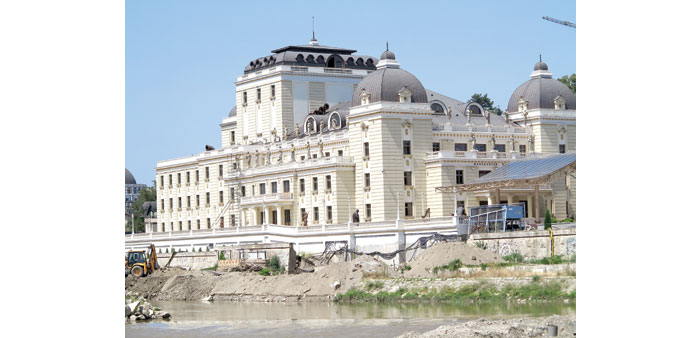IMPRESSIVE: The National Theatre in Skopje. The Macedonian capital Skopje is being rebuilt with expensive showy monuments and buildings to impress
By Thomas Brey
It would be a task for many to find Macedonia on a map of the world, or even on one of Europe. The poorest of the former Yugoslav republics mostly gains global attention when refugees storm trains to get out, or when ethnic conflict boils over.
A frenzied rebuilding programme in the capital, Skopje, is aimed at overturning patronising perceptions. Its advocates say Skopje is emulating the great big European cities with its own huge statues, fountains, bridges and even a triumphal arch.
Macedonia also wants to highlight its contested claims to an ancient and noble history it claims.
“We are paying homage to all our ancestors with these buildings,” Macedonia’s chief architect Vangel Bozinovski told dpa. “We are showcasing 8,000 years of our history.”
That claim directly contradicts the international scholarly consensus, even found in local Macedonian history books, which say that ancestors of the Slavic Macedonians arrived in the region from Asia in the sixth century during the Great Migration Period.
Neighbouring Greece is especially suspicious, perceiving Macedonia’s adulation of the world-conquering Alexander the Great as a covert way to lay claim to the Greek province of Macedonia.
“We did not immigrate. We were always here,” insisted Bozinovski.
The glorious history of Macedonia, which was Ottoman territory until 1912, is now supposedly represented in Skopje through two dozen neo-classicist buildings, around 40 monuments, the refurbished facades of Communist-era buildings, four new bridges and two large fountains.
It’s a big change from the old Skopje, where the centre was dominated by so-called brutalist buildings erected after a disastrous 1963 earthquake. The bare-concrete architecture ended up looking dreary.
The new Triumphal Arch — Porta Makedonija — near the parliament building has no relative in the past and is unusual for the present.
On the national day on August 1, a new water fountain was inaugurated amid great pomp and the cornerstone was laid for a massive Ferris wheel modelled on the London Eye.
Foreign critics have blasted the revamped Skopje, using words like kitsch and Disneyland to describe its awkward attempt to be pretty or posh.
Economic expert Branimir Jovanovic, of Solidarnost (Solidarity), a local organisation critical of the government, describes the construction effort of increasingly authoritarian conservative Prime Minister Nikola Gruevski’s government as an attempt to appeal to nationalists in Macedonia.
It became an independent country by splitting from former Yugoslavia 24 years ago.
The buildings’ appeal only addresses “Slavic” Macedonians — doing nothing for restive ethnic Albanians, who make up close to one-third of the 2.1 million inhabitants of the country. Albanians took up arms once in 2001 in a fight for more rights.
“It is a nationalist project directed against the Albanian minority,” concurs Ulf Brunnbauer, a historian from Regensburg, Germany and an expert for Macedonia.
During a rumbling year-long tussle with Gruevski, the opposition in May published wiretaps it had somehow acquired in which Gruevski issues detailed construction instructions to his ministers, talking about buildings he saw and liked abroad.
Locally renowned writer Aljosa Simjanovski estimated that the verdict on the new Skopje is yet due.
“The people are happy with it. Time will tell who was right,” he recently told the daily Utrinski Vesnik.
The style aside, critics blast Gruevski over the cost of the project.
The bill has grown from around 80 million euros (89 million dollars) in 2010 to 500 to 600 million euros now. The figures are an estimate, because the government keeps the expenditures for the development of central Skopje a top secret. —DPA visitors.

